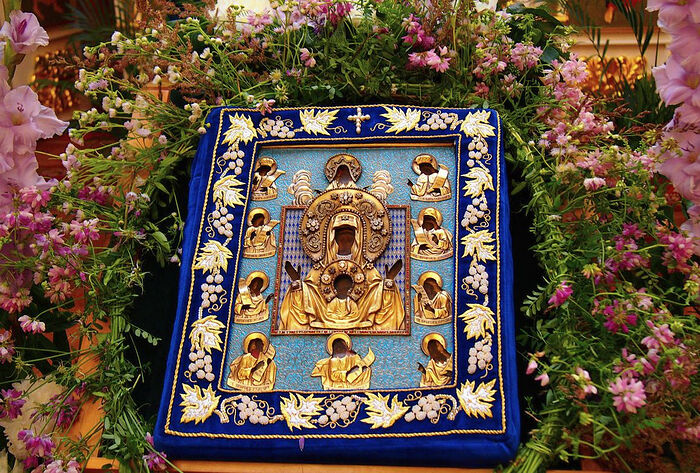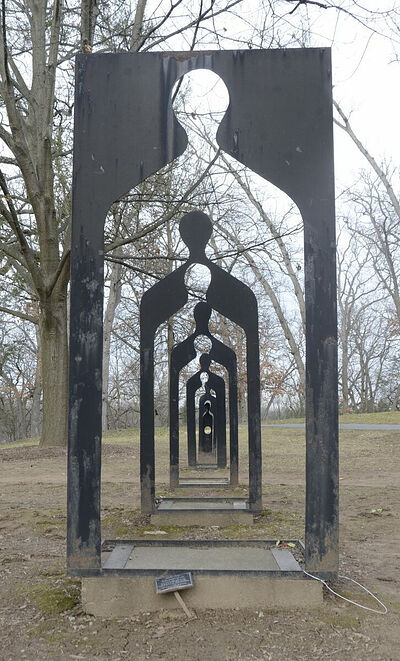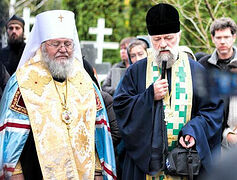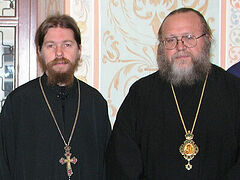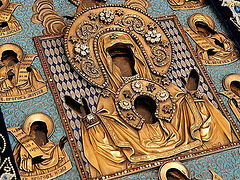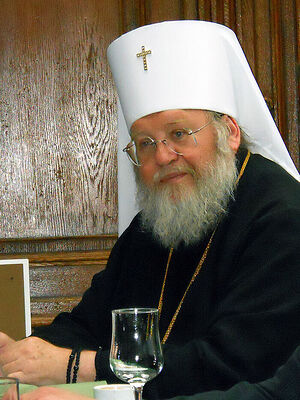 We chanted “Memory eternal” for our beloved Arch-Pastor Metropolitan Hilarion on the 40th day of his repose, the end of the formal period of prayers for the dead in the Orthodox Church, on Friday June 11 on the Church calendar (June 24 on the civil calendar). Vladyka Hilarion had blessed the start of our little mission in rural central Pennsylvania seven years before, and guided her growth. He was a true shepherd of our flock and of many others around the world, in his work as First Hierarch of the Russian Orthodox Church Abroad (ROCOR). From the first, as newcomers to ROCOR from another Orthodox jurisdiction, which had balked at setting up a mission in our small town, we felt his kindness and prayerful care.
We chanted “Memory eternal” for our beloved Arch-Pastor Metropolitan Hilarion on the 40th day of his repose, the end of the formal period of prayers for the dead in the Orthodox Church, on Friday June 11 on the Church calendar (June 24 on the civil calendar). Vladyka Hilarion had blessed the start of our little mission in rural central Pennsylvania seven years before, and guided her growth. He was a true shepherd of our flock and of many others around the world, in his work as First Hierarch of the Russian Orthodox Church Abroad (ROCOR). From the first, as newcomers to ROCOR from another Orthodox jurisdiction, which had balked at setting up a mission in our small town, we felt his kindness and prayerful care.
This same day for a “final farewell” for him, in terms of a Church service, was also the summer feast of the famous Kursk Root icon, a palladion of the Russian White Army in the civil war against the atheist Bolshevik oppressors of the Church, and chief icon of the Holy Synod that Metropolitan Hilarion headed, now based at the Manhattan home of the Synod where Vladyka lived in his last years and reposed. Throughout her history, the icon has symbolized the triumph of faith over worldly oppression, showing forth fulfillment of the long-prophesied “Sign” of the Lord that a Virgin would give birth to our Lord and Savior and God. Her summer feast on the ninth Friday after Pascha (the Orthodox Easter), coinciding this year with the 40-day prayers for Vladyka Hilarion, also fell on the date of the epic announcement of the historic overturning of the U.S. Supreme Court case Roe v. Wade.
Roe v. Wade‘s enshrinement of an asserted “human right” in the Constitution of the modern world’s wealthiest nation in 1973 encouraged a cultural of disposable life, inimical to the ancient Christian message of respect for life embodied in the icon and Metropolitan Hilarion’s life in that tradition. Under the materialistic legal regime established by Roe v. Wade, millions of children were sacrificed in officially sanctioned slaughter, larger in scale than the sacrifices of children by the Molochites in the Old Testament. Great has been the suffering for many children, mothers, fathers, and families, with spiritual wounds and sins too often un-repented-of by society at large, Lord have mercy on all! Great remains the need now for caring for those in need and their children. May we as Orthodox Christians turn toward Our Lady the Most Holy Mother of God, asking her prayer and intercession with her Son for all in need, beginning with ourselves, and for our right response.
The three events on the same day were linked spiritually and in remembrance. The type of depiction of the Theotokos in the Kursk Root Icon is called “the Mother of the Sign” because it highlights fulfillment of the prophecy of the Holy Prophet Isaiah, of that Sign from the Lord that a Virgin would conceive the Christ, the Logos, in her womb. The embodied Sign, Logos, the child Jesus Christ, fully God and fully man, came forth from her bodily, in a fathomless and wonderful mystery of redemption and care.
The Kursk Root icon depicts the Theotokos with Him before her, the Lord of Hosts above, and around her nine prophets who wrote about the birth of Christ centuries before, namely (clockwise starting on the top right) King Solomon, Prophets Daniel, Jeremiah, Elijah, Habakkuk, Judge Gidon, Prophets Isaiah, Moses, and King David. How great a cloud of witnesses across many generations! They foresaw the coming of the Messiah even in distant and dark times. In that foundational reality of the Christian faith lay the ultimate underscoring of the holiness of birth and babies, both a divine guarantee and historical reminder of the dignity of each human being, despite human tragedies and sins.
The dark and troubled times of the Old Testament trajectory toward the birth of Christ, illustrated in the icon, finds its echo in the history of the icon as well. As the ROCOR Synod website’s history of the icon notes, the Tatars had ravaged Russian lands, reducing the region of Kursk to an overgrown area sought out by hunters of wild beats. On 8 September, 1295, on the day of the Nativity of the Most-Holy Mother of God, a small force of hunters from Rylsk came to hunt at the Tuskora river, 27 versts from Kursk. One of the hunters, an honorable and pious man, seeking prey in the woods, found a small icon lying face down on the root of a tree. He had barely lifted it to inspect it when the spot upon which the icon lay burst out with a strong spring of pure water. The icon turned out to be of the type referred to as the “Sign” of the Mother of God. The hunter who found the icon knew that this was no ordinary occurrence. He called his companions and together they built a small wooden chapel, into which they placed this icon. The residents of Rylsk, hearing of the newly-appeared icon of the Mother of God, began to visit it for veneration, and many miracles began to appear from it.
in 1385 the Kursk region was swept again by the Tatars. They tried to burn down the chapel and its Icon, but the wooden structure would not burn. The priest who lived by the chapel, Fr. Bogolep, explained to them that the reason for this miracle was the Icon itself. The incensed Tatars hacked the Icon in half and tossed the pieces in different directions, then burned the chapel.
They took the priest prisoner and was forced to tend to Tatar flocks. Some time later he was ransomed by emissaries of the Muscovite Grand Duke who were on their way to the Golden Horde, and he returned to the place where the chapel had stood. After a long search, while praying and fasting, he found both halves of the holy Icon, placed them side by side, and they grew together seamlessly, exhibiting only something “like dew”.
The Kursk Root icon, and the help granted by the Mother of God, is linked with important events in Russian history, such as the war of liberation of the Russian nation during the Polish-Lithuanian incursion in 1612, and the 1812 Fatherland war. Several copies of the icon were made, which have also been associated with miracles.
In 1676 the holy Icon traveled to the Don River for blessing the Don Cossack troops. In 1684 Tsars Ivan and Petr Alekseevich sent a copy of this Icon with the order that it accompany Orthodox troops into battle. In 1687 the holy Icon was sent to the “Great Army.” In 1689 copies of the holy Icon were given to the armies in the Crimean campaign. In 1812 a copy of the holy Icon was sent to Prince Kutuzov and the battling troops. Before his icon St. Seraphim of Sarov prayed and was healed.
On the night of 7-8 March, 1898, conspirator revolutionaries-atheists tried to blow up the Miracle-working Icon with a hellish bomb, but the Lord Jesus Christ glorified His Most-Pure Mother yet more, for despite the terrifying destruction in the cathedral surrounding the Icon, it remained untouched.
On 12 April 1918, the holy Icon was stolen from the cathedral of the Monastery of the Sign of the Mother of God and stripped of its ornamentation, but on 2 May it was found and returned to its place.
Finally, in 1919, while accompanying Bishop Feofan of Kursk and Oboyan’ and some monks of the Monastery of the Sign, the holy Icon crossed the border to the neighborly Serbia. In 1920 it again, at the behest of General Wrangel, visited Russia at the Crimea and remained there until the final evacuation of the Russian Army in the first days of November, 1920. The holy Icon returned to Serbia, where it remained until 1944, when, together with the Synod of Bishops, it went abroad, to Munich (Bavaria) with Metropolitan Anastassy. In 1951 Metropolitan Anastassy moved from Munich to America. Since 1957 the Icon had resided in the main cathedral dedicated to it in the Synod of Bishops in New York. The holy Icon regularly travels to all the dioceses of the Russian diaspora
In early times when the icon was discovered, and after an old chapel nearby had been rebuilt to house it, it was moved to Rylsk to a new Church there. But the icon mysteriously disappeared and returned to the place of its appearance, and kept returning there, to the country place of what is now the Kursk Root Hermitage. The summer feast honors the time each year when the icon subsequently would be returned for the summer in a procession to that country site, on the ninth Friday after Pascha. It offers a gentle and usually unheralded reminder of the icon’s miraculous origins and history in the bosom of the Russian countryside, despite all manager of tragedy and upheaval.
Indeed, the icon has witnessed the renewal of the Orthodox faith worldwide in the global Russian diaspora during the time of the Bolshevik yoke, which had prompted the greatest loss of life and persecution of the Christian Church in history worldwide, and in travels since has witnessed the renewal of the faith in Russia after the fall of communism as well. Today, remembering the 40th day of the repose of our beloved Metropolitan Hilarion, whose life spanned that era, and also the Holy Kursk Root icon, we welcome in the United States the end of the nationally sanctioned oppression of millions of unborn babies, sacrifices to the materialistic yoke of Western consumerism and technocracy.
Heading into the future, a visible reminder of the spiritual wound of Roe v. Wade and its culture of officially promoted abortion will remain in the public art of the university campus where I work, in a sculpture of the Native American concept of the Seventh Generation. The sculpture represents the Iroquois or Haudenosaunee ethos that people should live and make choices that take into consideration our influence for good or bad on the seventh generation to come after us. The viewer of the sculpture can look through figures representing those coming generations. But, in the 1990s, pro-abortionist faculty twice vandalized the sculpture by removing a fetus featured as the “seventh generation” on it. Finally it was not replaced. Thus only six generations of the seven remain featured in the sculpture today. Yet the strange status of the seventh figure, like the biblical “fourth man” in the fire, may remind an Orthodox Christian considering the sculpture’s symbolism of the hidden presence of our Lord and God and Savior Jesus Christ, in Whose rule the world ultimately rests. He remains the Sign fulfilled, in the Logos made flesh, a little baby born in a cave in Bethlehem Who, as the Creed teaches us, shall come again in glory to judge the living and the dead, Whose kingdom shall have no end.
The Orthodox Christian cry of “memory eternal!” in prayers for the dead, heard on behalf of Metropolitan Hilarion at the gathering to mark the 40th day of his repose, echoes in the ending of a book often recognized as one of the world’s greatest works of literature, The Brothers Karamazov, by Fyodor Dostoevsky. There the exclamation is a call for the resistance to modernity’s self-assertion (which had been embodied in the idea of a “natural right” to abortion enforced nationally) by the Orthodox Christian ethos of self-emptying,, identified in the book with care of children.
Even so today, as Holy Scripture instructs us, we must not put our trust in princes and the sons of men, or in the vagaries of legal and political change in the secular world, but in our Lord Jesus Christ and in His Church, our mother. The Kursk Root icon exemplifies the intercessory care for His Church by His Mother, the Most Holy Theotokos. Metropolitan Hilarion laid down his life for us to show us this. May his example and prayers help sustain us through uncertainties ahead, and may his memory be eternal!
Most Holy Theotokos save us! Lord Jesus Christ have mercy on us!

